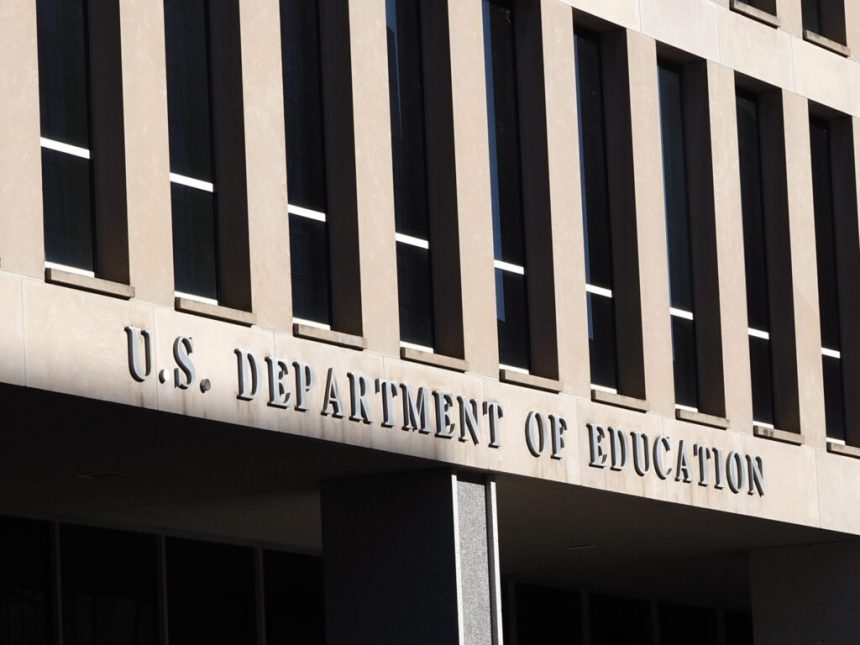The Lyndon Baines Johnson Department of Education Building pictured on Nov. 25, 2024. (Photo by Shauneen Miranda/States Newsroom)
Indiana is asking the federal government for permission to overhaul how it spends and tracks billions in education aid — a request that Hoosier officials said would align the state’s accountability system with federal law and allow more freedom in how schools use their funds.
The request, submitted Friday to U.S. Education Secretary Linda McMahon, seeks a waiver from multiple provisions of the Elementary and Secondary Education Act, or ESEA, the federal law governing K-12 education.
Indiana Secretary of Education Katie Jenner speaks before the state’s higher education commissioner on Friday, Aug. 22, 2025, in Indianapolis. (Photo by Casey Smith/Indiana Capital Chronicle)
If approved, the changes would take effect beginning in the 2026-27 school year.
State education leaders framed the proposal as an effort to “prioritize student learning over federal bureaucracy.” Indiana Secretary of Education Katie Jenner said the state’s message to federal officials was clear.
“With the opportunity to return education back to the states, we had a clear choice to make in Indiana: continue with the status quo or seize this moment to gain the flexibilities needed to remove federal barriers to more urgently move the needle for students,” Jenner said in a Monday statement. “As a state, we are leaning in to seize this moment, and today, our message to Washington is clear: Indiana is ready and eager, so give us the flexibility to keep driving forward for Indiana students.”
Gov. Mike Braun also praised the move, calling it proof that “Indiana continues to lead the nation in education and innovation.”
“We can best support Hoosier students when we return education to the states, empower parents with high-quality educational options, get red tape out of the way for educators, and focus on improvement for every student,” he said in a news release.
Streamlining federal programs into one ‘block grant’
The 19-page waiver application outlines a plan to simplify how federal dollars are administered and to align Indiana’s accountability system with federal requirements.
The state’s proposal centers on four main areas of flexibility: streamlining federal funding, easing local compliance, creating an innovation fund, and unifying accountability metrics.
In its filing, the Indiana Department of Education asked to combine funding from more than 15 federal education programs — including portions of Titles I, II, III and IV — into a single “strategic block grant.”
Those programs make up the bulk of federal K-12 aid: Title I supports schools serving higher percentages of low-income students; Title II funds teacher training and professional development; Title III provides extra assistance for English language learners; and Title IV helps schools expand “well-rounded” education programs, boost safety initiatives and increase access to technology.
Story continues below.
Indiana ESEA Flexibility Request w. Cover Letter
Indiana officials argued that managing those programs separately consumes significant time and resources. The waiver emphasized that IDOE currently spends about $2.2 million annually in staff time to support the administrative infrastructure required to meet ESEA compliance demands, with roughly 75% of that amount — about $1.7 million — dedicated solely to compliance and reporting rather than to initiatives that directly advance student achievement.
By consolidating those programs, officials said the state agency can redirect resources toward its top priorities, like early literacy, STEM education and high school redesign.
The filing compares Indiana’s management of the federal COVID-era ESSER relief funds, which the department described as a “more efficient” block grant model that allowed it to “move with urgency” and “align resources with its most pressing educational priorities.”
The waiver additionally seeks to extend similar flexibility to school districts by allowing them to merge multiple federal grants into a single plan.
Department officials argued that the change would simplify paperwork and monitoring, reducing what they describe as a “burdensome regulatory environment” that often discourages “innovation” at the local level.
Under the new system, districts would complete one consolidated application and monitoring process, rather than separate plans for each federal program. That streamlined process would “free up time and staff to focus on what matters most: effective implementation, real-time progress monitoring, and continuous improvement,” according to the waiver.
Rethinking how school improvement funds are used
A major component within the request is the creation of a new “Education Innovation Grant” to replace the current federal School Improvement Grant structure.
State officials said the change is needed to address long-term underperformance in some schools. The department cited national and state data showing that despite years of federal investment, many schools identified for improvement under ESEA remain among the lowest-performing.
“Students and families cannot wait — sometimes for years — for a chronically underperforming school to improve,” the application urged. “(Grant flexibility) allows the money to support the child, rather than continuing to be trapped in a system that year over year is yielding negative results for children.”
Story continues below.
The proposed new approach would allow Indiana to direct about $25 million in annual federal school improvement funds to any district or program — such as charter schools, microschools, or partnerships with industry or higher education — that serves students zoned to attend persistently underperforming schools.
Hoosier officials argued that expanding eligibility would promote “student-centered solutions” and reduce the stigma associated with receiving federal school improvement dollars.
The state’s waiver also proposes aligning its new, forthcoming A–F accountability system with federal reporting requirements. Indiana officials say the move would end the confusion caused by schools currently receiving two different performance ratings—one for federal purposes and another under state law.
“This flexibility allows IDOE to tailor interventions to the state’s most urgent and localized needs,” the waiver notes, adding that a unified system would “provide families with clear, consistent school ratings to support informed decision-making” and “reduce complexity and increase clarity.”
Need to get in touch?
Have a news tip?
The state would continue to publish annual report cards that break down outcomes by subgroup, but would shift how it packages and uses the funds behind those report cards.
Jenner described the request as part of a broader effort to “advance student outcomes through innovation, flexibility, and a relentless focus on academic excellence.”
In her cover letter for the waiver, she pointed to recent gains, including a five-percentage-point increase in third-grade literacy rates in 2025 and Indiana’s rise to sixth in the nation in fourth-grade reading scores. She also cited record-high graduation rates, improved math proficiency, and a reduction in chronic absenteeism since 2021.
The department emphasized that the waiver would not alter how federal funds are distributed to districts or change the “supplement, not supplant” requirement that ensures federal dollars enhance rather than replace state and local spending.
Teachers’ union urges caution
Federal education officials encouraged all states in July to consider ESEA waiver requests that would give them “more control” over how federal education dollars are used.
At least two states —Iowa and Oklahoma — have already similar flexibility requests.
But the Indiana State Teachers Association previously urged caution, arguing that the waiver could weaken oversight and divert resources away from schools that need them most.
In an Aug. 18 statement, ISTA leadership said it supports efforts to reduce administrative burden “when it can be done without undermining educational equity or outcomes for students,” but warned that consolidating federal programs “risks weakening” the rights of educators and parents to participate in decisions about federal funding.

Ron Sandlin, Indiana Department of Education’s chief innovation officer (Photo courtesy IDOE)
The state’s largest teachers union also raised concerns that shifting school-improvement dollars “away from public schools identified for additional support … to other entities such as microschools, charter schools, or partnerships with industry or higher education institutions” could “redirect these funds to schools or programs that are not necessarily serving the students most in need.”
Still, at the July 16 State Board of Education meeting, IDOE senior official Ron Sandlin previewed the proposal and described it as a “continuation of Indiana’s commitment to innovation.”
Sandlin told board members the flexibility waiver “is not about reducing accountability or transparency,” but rather “about aligning systems so we can spend more time serving students and less time checking boxes.”
He said the plan is designed to “reduce bureaucratic compliance, empower local decision-making, and eliminate duplicative systems by adopting a single accountability framework for both state and federal requirements.”
Under federal law, the U.S. Department of Education has 120 days to review Indiana’s submission and provide a response. If approved, the changes would take effect beginning with the 2026–27 school year.
“The opportunity to return education to the states,” Jenner wrote in her letter, “allows us to further reduce burdensome federal compliance demands and empower our local leaders, in collaboration with parents and families, to make informed decisions about what Indiana students need most.”
SUBSCRIBE: GET THE MORNING HEADLINES DELIVERED TO YOUR INBOX









